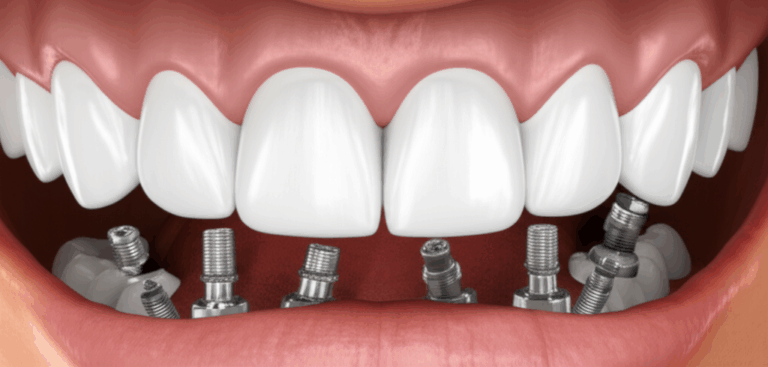
What Holds Dental Implants in Place? The Science of Stability and Long-Term Success
Dental implants feel just like real teeth—but what keeps them so steady in your mouth? In this article, I’ll show you how a mix of science, smart design, and good habits make dental implants a solid answer. You’ll learn what’s going on under your gums, why implants are so strong, and what you can do to keep your new smile safe. If you want to feel good about dental implants, you’re in the right spot!
Table of Contents
What Are Dental Implants?
Dental implants are fake tooth roots. They take the place of missing or broken teeth. Think of a small screw that goes deep into your jawbone. But this screw is made for your body and bone. Once it’s in, a dentist puts a connector called an abutment, and then a special-made crown—your new “tooth”—on top.
Parts of a Dental Implant:
- Implant fixture (the “root”): The part put into your bone.
- Abutment: The bit that joins the implant to the crown.
- Dental crown: The tooth-shaped cap you see in your mouth.
In my talks with patients, most are shocked at how normal their dental implants feel—almost like they forgot they even have one!
Why Do Dental Implants Feel So Secure?
Here’s the big question: why don’t dental implants wobble or come out like some false teeth? The answer is:
Unlike fake teeth you can take out, implants become part of your jaw. That means you can eat apples, have a good laugh, and never stress about things slipping out.
If you’ve ever had loose teeth, you know how hard biting into a sandwich can be. Dental implants fix that for good.
What Is Osseointegration?
Let’s talk about the secret behind every tough dental implant: osseointegration.
Osseointegration means your jawbone actually grows right onto the implant’s outside. It isn’t glued. It’s not snapped in. It’s stuck on naturally.
Think of how a tree’s roots grow into the ground, keeping it steady, year after year. In the same way, your bone grabs the implant. After a few months—usually 3 to 6—your implant becomes part of your jaw.
How does it happen?
- The implant (like titanium) is a great spot for bone cells.
- Your healing cells gather around the implant and start to hold on to it.
- In time, the lock becomes so tight, it can be just like a real tooth’s root.
What’s Inside a Dental Implant? Let’s Break It Down
Dental implants are clever, but not hard to get. Each one has three main parts, and each does something special to keep your new tooth steady.
| Part | Nickname | What It Does |
|---|---|---|
| Implant fixture | The Root | In your jaw and holds everything up |
| Abutment | The Connector | Joins the tooth to the implant |
| Crown | The Tooth | The part you bite and show when you smile |
Implant Fixture:
Put into your jawbone, this bit has a good grip because of the screw shape and gets even stronger as the bone grows around it.
Abutment:
Acts like a “middle piece” between the implant and crown. Think of it as the “neck” joining the root and the tooth.
Crown:
This is the part you’ll see. It’s made to look just like your other teeth—no one will ever guess it’s not real!
Want to know where the dentist gets these special fake teeth made? Check out a crown and bridge lab.
How Does the Jawbone Hold Implants in Place?
A dental implant’s best friend is not glue or sticky stuff—it’s your own jawbone.
Here’s what happens:
- Right after surgery, your bone grabs the implant by its grooves and surface (called primary stability).
- As you heal, bone cells grow onto the implant and make the hold even stronger (secondary stability).
If your bone isn’t strong, implants just don’t work as well. That’s why sometimes you need a bone graft if your jawbone is too thin or weak.
Fun Fact: People with strong, healthy bones have the best luck with dental implants.
What Happens During the Healing Period?
Right after you get an implant, your mouth might feel sore or puffy. But this is when the good stuff happens—the healing period.
- First weeks: Your implants stay covered up by your gums, safe from chewing.
- 3–6 months: Your bone gets to work growing onto the implant through osseointegration.
- 6–12 months: The hold between bone and implant gets even firmer.
The best thing you can do? Follow your dentist’s advice—brush gently, don’t eat hard foods, and never smoke while healing.
Easy analogy:
Think of planting seeds in the dirt. You have to cover them, water them, and keep them safe. Then, roots grow deeper, and the plant can stand on its own.
Which Materials Make Implants So Strong?
There are a lot of materials out there, but titanium and zirconia are the top choices for dental implants.
Titanium
- Has been used for a long time
- Very strong but also light
- “Body friendly”—your body likes it
- Made with a special coat so bone can grow on it faster
Zirconia
- Tough, white material
- Great for people who can’t have metal
- Super strong and won’t collect much plaque
Dentists use special ways—like roughing up or treating the surface—to make implants easier for bone to hang on to, a bit like Velcro for your mouth.
Many top implant brands use these rougher finishes. This helps dental implants last a really long time.
What Could Make an Implant Loose or Fail?
Dental implants are strong, but not unbreakable. Here are some things that might make an implant loose or not work:
If the bone does not grow onto the implant, it can’t support the tooth.
This is an infection around the implant from poor brushing or flossing. If germs grow, bone goes away, and the implant can get loose.
Sometimes the connector can loosen, or the crown might break off if you bite into something really hard.
Grinding your teeth or chewing on ice puts too much force on your implant—this can loosen it or hurt the bone over time.
These health problems make it hard to heal, and there’s a bigger risk of infections or bone loss.
If your implant feels loose or wiggly, see your dentist as soon as you can.
How Can You Keep Your Dental Implants Secure?
Great news: with good care, most people keep their dental implants for many, many years—even for life! Here’s what you can do:
- Brush and floss every single day
Use a soft brush and gentle floss around the implant tooth. Maybe try a water flosser too.
- See your dentist twice each year
Regular check-ups find little problems before they get big.
- Don’t smoke
Smoking slows down healing and makes bone loss worse.
- Wear a nightguard
If you grind your teeth when you sleep, think about a custom night guard dental lab piece to protect your implants and real teeth.
- Eat healthy
Foods with lots of calcium and vitamin D help your bones.
Are Implants Right for Everyone?
Most healthy adults can get implants, but not everyone is a good fit. Dentists will check:
- Jawbone (you need enough for support)
- Gum health
- Your whole health (it’s better if you don’t smoke or have hard-to-control diabetes)
Sometimes dentists use cool scans and models—often made in a digital dental lab—to be sure of the best fit and spot.
If you’re missing a bunch of teeth, or even all of them, ask your dentist about things like All-on-4 implants or implant-supported dentures. These can give you a strong, full new smile.
Case Studies and Surprising Facts
Let’s check out some numbers:
- Dental implants have a success rate of 95-98% over 10 years. That’s way better than most things you fix around the house!
- The main reason for loose implants later on is infection around the implant (peri-implantitis), which causes about 28–56% of misses.
- Smokers are 2–3 times more likely to have trouble than non-smokers.
- People who visit their dentist every 6–12 months have fewer implant problems and infections.
Here’s a true story. One patient, let’s call her Anna, lost a tooth after a fall. She was worried about having metal in her jaw but soon felt her titanium implant just like a real tooth. Two years later, she says, “It’s even stronger than my real teeth ever were!”
Many modern dental labs use smart new tools and materials to make lifelike crowns and implant parts—like those in a top chinadental lab.
Summary: The Big Picture
Problem: Losing a tooth makes eating, smiling, and feeling good about yourself harder. You might worry nothing will ever stick for good.
Agitate: Gaps in your smile can make eating tough, and loose fake teeth or bridges can move and be embarrassing. If you wait, you can lose bone in your jaw, which makes things even harder to fix later.
Solution: Dental implants fasten right to your jawbone with bone fusion—your body’s natural way to stick things. Made from strong, safe stuff like titanium and zirconia, they use smart parts to hold new teeth that don’t wiggle. With regular care, dental implants are a tough, lasting way to eat, talk, and laugh with confidence.
Key Points to Remember:
- Dental implants stay put because of bone fusion and smart design.
- Osseointegration is how your bone locks in implants like real roots.
- Healthy bone and good habits keep implants working for years.
- Most implant problems can be stopped with good brushing and dentist visits.
- Today’s dental labs use tech and quality stuff to make implants look and feel like real teeth.
Frequently Asked Questions
Q: How long do dental implants last?
A: Most last for many years—sometimes your whole life! Good brushing, flossing, and going to the dentist help them last the longest.
Q: Can anyone get a dental implant?
A: You need healthy gums and enough bone. Some problems, like tough-to-control diabetes or smoking, can lower the chance of success.
Q: Does getting an implant hurt?
A: Dentists use numbing and gentle steps so you’re comfy during the process. Most people say it’s easier than a tooth pulled.
Q: Will my implant look like a real tooth?
A: Yes! Dental crowns are made to match your teeth, using skilled folks in a dental ceramics lab.
Q: What do I do if my implant feels loose?
A: Call your dentist right away. Early help is often a quick fix.
Smile big, knowing dental implants are the next best thing to having your own teeth back—maybe even better!








